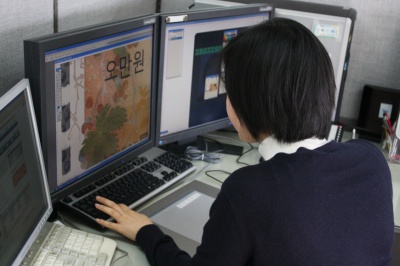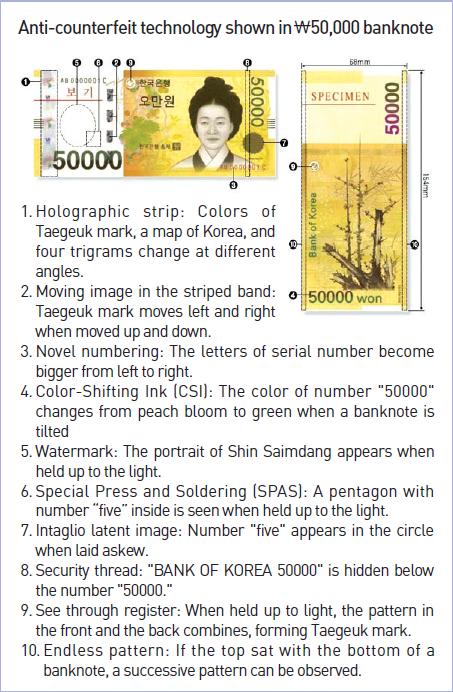Banknote designer, seeking for both creativity and security
LET’S OPEN up our wallets and see what’s inside. A bundle of banknotes, some coins, and ID cards… These things are a crucial part of everyday life, but most people are not interested in how they come into the world. Yet even if a ₩1,000 banknote seems like just a piece of paper, it contains Korea’s history, culture, and most importantly, its state-of-the-art technology. The Yonsei Annals visited Korea Minting & Security Printing Corporation (KOMSCO) to witness magical hands creating the history of Korea.
What is a banknote designer?
A banknote designer is a person who is in charge of designing not only new banknote but also coins, passports, medals, ID cards, checks, certificates, stamps, and even Christmas seals. Up until 1982, Korea requested banknote designs from foreign countries such as Japan or the United Kingdom, since it did not have its own engraving technologies. After 1983, however, design and anti-counterfeit technologies began to develop, and the ₩10,000 banknote was produced on our own for the first time. This phenomenon has contributed to a growing number of banknote designers, making Korea one of the countries with the most sophisticated skills in the world. Currently, there are only eight designers in the design department of KOMSCO, and less than 200 banknote designers in 20 countries worldwide, showing that banknote designers are rare but quite crucial for the country.

Before a new banknote comes out
Designing a banknote involves a complicated process that usually takes two years or more. It may even take much longer since the process is conducted by both The Bank Of Korea (BOK) and KOMSCO. The ₩50,000 banknote took about two years to be issued. When BOK requests that KOMSCO design a banknote, KOMSCO has to decide the historical figure, objects, and must then await approval by BOK before the process can move forward. Then, banknote designers determine the basic features of the banknote, such as size, design, printing method, anti-counterfeit techniques, and start to sketch the design out following various steps. First a rough draft is made, and then a detailed sketch, with coloring added to the picture. Even once it has been colored, a banknote must go through numerous modifications until the final draft comes out. This final draft must then be confirmed by the BOK.
Once it has been approved by BOK, the banknote passes through lithography and intaglio printing. Designers proceed to make a detailed sketch according to the demands of the printing method, and insert security devices such as hologram*, security thread, security fiber, and watermark* which are important elements to prevent illegal copying. After several printing runs, in which mistakes are corrected, the final printing of the banknote comes out, receives the BOK’s final approval, and eventually goes out into the world and our wallets.
* Hologram: a three-dimensional photographic image created by laser beams.
* Watermark: a design put into paper that can be seen only if you hold the paper up into the light.
How to become a banknote designer
Unfortunately, KOMSCO is the only organization that fosters banknote designers in Korea. Therefore, people who desire to be a banknote designer should join KOMSCO through open recruitment, and usually employment is possible only when there is a vacancy. All applicants have to pass through three stages - document screening, performance test, and an interview. Since designing a banknote demands great accuracy and skill, the performance test is the most important part of the process, and a successful applicant must have a high degree of artistic competence. Yet even after entering KOMSCO, applicants are not put to work immediately, but build up experiences through three or four years of training. This is necessary since designing a banknote is quite different from designing other products, and involves a complicated process. It takes almost ten years to be recognized as an expert in this field, which requires much more patience than most other occupations.
Tough but worthwhile
The best banknotes come into being when three factors - pictures, security features, and design - are joined together in a balanced way. It is very difficult to arrange the security devises within a limited space in a manner that is both convenient and aesthetically pleasing. It is hard to select historical figures to appear on the banknote, since they must appeal to the different classes of society. Moreover, every picture of a banknote should be drawn by hand with numerous thin lines between 1/8 and 1/9mm thick, and designers must make sure there are no mistakes in the printing process before the final print is made. For these reasons, issuing a new banknote takes much more time and effort than people usually think.
Nevertheless, banknote designers feel that their work is worthwhile, since designing a banknote is a quite a rare opportunity. “Every banknote is changed every 24 years, which means designing a new banknote is like making a new history of our country. I felt very proud of myself when a banknote I designed was displayed in the BOK Museum,” says Hong So-young (Assistant Research Manager, Dept. of Design & Engraving, KOMSCO). Although their efforts may not be known to the public, people use their historical masterpieces every day.
An interview with a banknote designer

Hong So-young (Assistant Research Manager, Dept. of Design & Engraving, KOMSCO)
Annals: Was there a special incident while working as a banknote designer?
Hong: Once, there was a medal design contest for the 2002 Busan Asian Games. As the pictures on each medal should convey the history and culture of the venue, I chose seagulls and Oryukdo as the symbols of Busan for the main theme. On the medal, I put in a pattern with octagonal pavilion, which I thought would represent both the tradition of Korea and show the unique beauty of our country. Fortunately, my work was received high praise, and it was selected as the best one.
What qualities are needed for a banknote designer?
Basically, a banknote designer should have an aesthetic sense, but more importantly, one should be a meticulous person for this job. From the beginning of the sketch to the final print, a banknote designer should watch all the process and find out errors even if a mistake is a tiny single line. Therefore, he or she should have patience to complete a perfect piece. Besides, having enough knowledge of history and culture of Korea would be helpful in understanding a banknote and providing a creative idea for designing.


